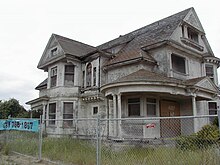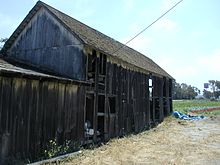
During World War II, the United States, by order of President Franklin D. Roosevelt, forcibly relocated and incarcerated at least 125,284 people of Japanese descent in 75 identified incarceration sites. Most lived on the Pacific Coast, in concentration camps in the western interior of the country. Approximately two-thirds of the inmates were United States citizens. These actions were initiated by Executive Order 9066 following Imperial Japan's attack on Pearl Harbor. Of the 127,000 Japanese Americans who were living in the continental United States at the time of the Pearl Harbor attack, 112,000 resided on the West Coast. About 80,000 were Nisei and Sansei. The rest were Issei immigrants born in Japan who were ineligible for U.S. citizenship under U.S. law.

Pajaro is an unincorporated community and census-designated place (CDP) in Monterey County, California. It is located on the south bank of the Pajaro River 5 miles (8 km) northeast of its mouth, at an elevation of 26 feet (7.9 m). The population was 2,882 at the 2020 census, down from 3,070 in 2010. The school district is in Santa Cruz County.

Watsonville is a city in Santa Cruz County, California, in the Monterey Bay Area of the Central Coast of California. The population was 52,590 at the 2020 census. Predominantly Latino and Democratic, Watsonville is a self-designated sanctuary city.
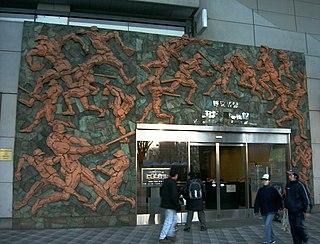
The Japanese Baseball Hall of Fame and Museum is a museum which includes a library, reference rooms and Japanese Baseball Hall of Fame.

Itō Noe was a Japanese anarchist, social critic, author, and feminist. She was the editor-in-chief of the feminist magazine Seitō (Bluestocking). Her progressive anarcha-feminist ideology challenged the norms of the Meiji and Taishō periods in which she lived. She drew praise from critics by being able to weave her personal and political ideas into her writings. The Japanese government, however, condemned her for challenging the constructs of the time. She became a martyr of the anarchist ideology in which she believed during the Amakasu Incident, when she was murdered along with her lover, anarchist author Ōsugi Sakae, and his nephew.

Adolph Claus J. Spreckels was a major industrialist in Hawai'i during the kingdom, republican, and territorial periods of the islands' history. He also involved himself in several California enterprises, most notably the company that bears his name, Spreckels Sugar Company.
Westphalia is a small unincorporated community in Falls County, Texas, United States, located 35 mi (56 km) south of Waco on State Highway 320. Westphalia has a strong German and Catholic background. The Church of the Visitation was, until recently, the largest wooden church west of the Mississippi River. Westphalia is mainly noted for its historic church and convents, but also for its meat market and for its annual church picnic, which is one of the largest in the area. Westphalia is also known for the Westphalia Waltz.

Driscoll's is a California-based seller of fresh strawberries and other berries. It is a fourth-generation family business that has been in the Reiter and Driscoll families since the late 1800s. In 2017, it controlled roughly one-third of the $6 billion U.S. berry market. Headquartered in Watsonville, California, Driscoll's develops proprietary breeds of berries and then licenses them exclusively through approved growers.
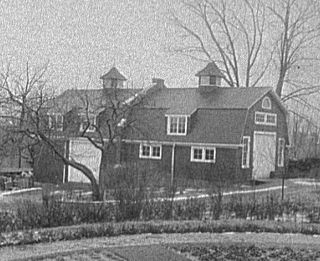
A carriage house, also called a remise or coach house, is an outbuilding which was originally built to house horse-drawn carriages and the related tack.
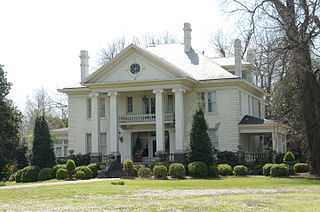
The Dortch Plantation, also known as the William P. Dortch House or the Marlsgate Plantation, is an historic house near Scott, Arkansas. Dortch House is the only plantation home in Arkansas that is fully furnished in the antebellum period style and available for tours and private events.
Beardslee Farm is a national historic district and farmstead located at Pittsfield in Otsego County, New York. It encompasses five contributing buildings, one contributing site, and one contributing structure. It consists of the farmhouse, dependencies, and a small family cemetery. The "L" shaped farmhouse is a large sprawling wood frame residence comprising three sections that reflects three separate building campaigns, ca. 1790, ca. 1800, and ca. 1810. The main section is a two-story, five bay building with a center entrance and a gable roof. Also on the property is a horse barn, carriage house, corn house, hop barn, and pump house.

The Campbell–DeYoung Farm is a farmstead located at 9510 East Cherry Bend Road in Elmwood Charter Township, Michigan. It is currently operated as a recreational area by the Leelanau Conservancy, and known as the DeYoung Natural Area. It was listed on the National Register of Historic Places in 2011.

The Parsons–Piper–Lord–Roy Farm is a historic farmstead at 309 Cramm Road in Parsonsfield, Maine. Its buildings dating to 1844, it is a fine example of a well-preserved mid-19th century farmstead, with modifications in the 20th century to adapt the barn to chicken farming. The property was listed on the National Register of Historic Places in 2005.

Naomi Hirahara is an American writer and journalist. She edited the largest Japanese-American daily newspaper, The Rafu Shimpo for several years. She is currently a writer of both fiction and non-fiction works and the Edgar Award-winning Mas Arai mystery series.

Drake Farm is a historic farmstead at 148 Lafayette Road in North Hampton, New Hampshire. Built in 1890, the main farmhouse is a well-preserved example of a connected New England farmstead. It was listed on the National Register of Historic Places in 2016.
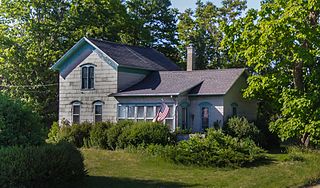
The Rock S. Edwards Farmstead is a collection of farm buildings located at 3503 Edwards Road in Sodus Township, Michigan. It was listed on the National Register of Historic Places in 1995.

Ichiko Kamichika (神近 市子, Kamichika Ichiko) was a journalist, feminist, writer, translator, and critic. Her birth name was Ichi Kamichika and her pen name was Ei, Yo, or Ou Sakaki(榊 纓). After World War II, Kamichika served in the Japanese House of Representatives as a member of the Japan Socialist Party.

The Benjamin and Maria (Ogden) Drake Farm, also known as the Drake Farmstead, is a farmstead located at 927 North Drake Road in Kalamazoo, Michigan. It was listed on the National Register of Historic Places in 2012, and as of 2021 is open to the public as the Drake Farmstead Park.
The TashmeIncarceration Camp was a purpose-built incarceration camp constructed to forcibly detain people of Japanese ancestry living on the West Coast of Canada during World War II after the attack on Pearl Harbor. Located at the current unincorporated community of Sunshine Valley, east of Hope in British Columbia, Canada, Tashme was operational between 1942 and 1946 and had a peak population of 2,624 people to 2,636 people. Tashme was constructed on 600 acres of leased land for $500/year on the A.B. Trites Farm.
Frank Fujio Chuman is a Japanese-American former civil rights attorney and author, involved in several important Japanese American civil rights cases and in the redress movement.
